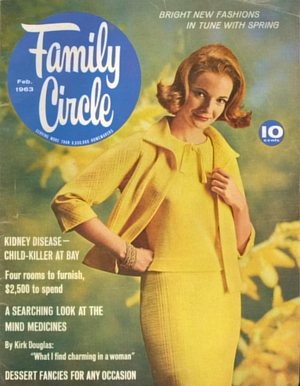After having gotten my start as a seller on eBay selling books, I found I was having a tough time. I love books, and enjoy sifting through them, looking at them, reading them and selling them. I once worked in Waldenbooks in my youth. But as I found very quickly, books are a tough sell on eBay. There’s nothing that creates more competition than an item that was mass produced in the millions, and that hundreds of other people are trying to sell. Hardcovers in particular are prized by their owners, who are loathe to give them up for a low price. eBayers, however, don’t seem to value hardcovers more than softcovers, despite popular belief to the contrary. So I found myself dealing mostly in vintage paperbacks.
Then I happened across an estate sale which had a large collection of old magazines from the fifties. These were mainly Ladies’ Home Journal, Life and The Saturday Evening Post. Honestly, they weren’t in very good condition. The spines were so frayed they were all but gone. Some had large sections cut out of the covers or pages. I decided to pick up a few, since they were super cheap, but wasn’t about to make a large investment in time, energy, or money.
I quickly found myself regretting my decision. “Oh, why on earth did I buy these? They’re never going to sell!” They sat on a shelf, unlisted, for a long time. I finally broke down and listed them in the store for low prices, usually around $4.95, to compensate for the poor condition and sell them more quickly.
The next thing I knew, Ladies’ Home Journals were flying out the door.
I was floored. The buyers were begging me for more Ladies’ Home Journal. There were specific issues from the fifties that they were looking for, and hadn’t been able to find. Please, please, please, could I get them MORE?!?! It seemed that Ladies’ Home Journal was food for a starving mind. I couldn’t have been more surprised.
It seemed, as my experience with magazines grew, that magazines were actually better sellers than books. And almost any magazine would sell (well, at least some of them). Sometimes I could sell them for good prices from the store, but if not I could generally liquidate them in lots at auction. And they were typically severely undervalued at estate and garage sales, often selling for under $.50 per copy. Definitely, these were better items for resale than antiquarian, hardcover books at estate sales that cost a dollar or more per copy, and definitely better than paperbacks.
It just goes to show, you can’t judge a book by its cover, or rather, your own preconceived notion of the cover. Many of the magazines that we typically tend to devalue ourselves are actually in very high demand on eBay. That’s why they’re such great high-profit items. Which leads me to another subject.
The generally accepted practice for selling for a profit is to mark up an item to twice what you paid for it. Trouble is, this practice often doesn’t work on eBay, mainly due to the fees. In this market on eBay, if you’re selling used items, antiques, or anything that’s not on the “Hot List,” you should look to get at least five times your “Cost of Goods Sold,” (i.e. what you paid the owner in exchange for the item), preferably ten or twenty. This is because you have your overhead; telephone and internet service, other costs to obtain the item (such as gas and time driving around to sales, or shipping for a lot you bought online), and more, depending on how you run your business or how you like to sell as a hobby. Then you have fees. Fees, fees, fees, fees, and more fees. eBay will charge you not only for any item that sells, but also for any item that doesn’t sell. Then if you have a store, subscribe to marketplace research, or other eBay services, that adds to your costs all the more. You’re being nickeled and dimed to death. Only double your cost for the item, and you will quickly reach the point where you’re only breaking even, and in some cases even losing money, and you won’t even know it, because you haven’t kept track of all those nickels and dimes. You’re working very hard for nothing.
The next issue you’ll deal with is unsold items. And I’m not just talking about items that failed to sell in a week. These are items that never sell. And you will have them, if you decide to sell magazines. Prepare to be buried under a pile of magazines. I have them stacked in boxes all over the office. Sell them in sufficient quantity, and you’ll have to get warehouse space. Many of them, as I’ve stated, will sell in lots at auction for what you paid for them or more. If they do, you are lucky indeed. But some magazines can be hard to get rid of. Every item that never sells and must be given to charity or sold at a loss is money out of your pocket and constitutes a loss of revenue. So consider all of these costs when buying and selling your magazines, even if you’re only doing it as a hobby or to clean out the garage. And never feel bad about charging a fair price for your magazines simply because you got them for cheap or for free. Magazines are hard work, especially the old ones. They’re heavy and hard to move around. Sometimes they’re dirty and need to be cleaned or aired out. Photography is a major undertaking and can hurt your back. You deserve to be paid for your efforts.
A picture is worth a thousand words. So get a really good picture of your item. The best way is to scan them. For older magazines, however, unless you’ve got an oversized flatbed scanner, you will need a good digital camera. I recommend 5 megapixel or higher. Anything less and you’re going to end up with a blurry picture. Lay your magazine on something with an interesting texture that isn’t too busy, like a tile floor, a sheet, blanket or towel. The most important element in photography is lighting. It’s also the thing you’re going to have the most trouble with. I generally try to shoot pictures during the day whenever possible, in combination with artificial light. The combination of natural and artificial light will help you to get the clearer picture you’re after, and avoid the purchase of costly lighting equipment. Try to avoid using the flash if possible; but if you must use it, you’re probably all right, since paper items generally look better under the flash than three-dimensional objects. Import your pictures into an inexpensive image editing program like Paint Shop Pro. Rotate, crop and resize them so they look nice and are not too unwieldy. Watermarking your images with your user name will keep other eBayers from stealing your hard work. I use the text tool in Paint Shop Pro for this.
A common misconception is that magazines qualify for media rate. They don’t. The advertising content in your magazines can get your magazines sent back to you to ship to your customer all over again at your own cost. A lot of people get away with shipping media, but I say it’s not worth the risk. Ship them Parcel, or better yet, head to the eBay Shipping center, order yourself some free, co-branded Priority Mail shipping boxes and when they arrive, give your customer a free shipping upgrade. There is also a service called Bound Printed Matter which you can use. I don’t recommend it. If your package becomes lost in the mail, the post office will not return the package to you, but will rather throw all your precious cargo away right there in the Post Office. However, if your customer insists on cheaper shipping, you can use this as a fall-back strategy. Be sure to inform your buyer of the risks to this service, and always user confirmation.
One trick for selling your magazines is never to set the opening bid too low. This is a very common error that many sellers make that cause them to lose their item for too low a price. This is because of eBay’s blanket suggestion to sellers that a lower starting bid can generate more bidding activity. Well, I say, not when it’s a magazine. Most of the magazines that I sell get only one bid, and even most of the best ones generally never get more than two. It’s rare to find a magazine that sets off a lot of bidding, and even then, setting that bid too low can backfire. Go ahead, price it high; you’ll thank yourself. Better to lose that money on a listing fee than to lose it on an item that sold for too little.
The next trick is to list important and crucial points from the contents of the magazine. I know; that’s an unbelievable amount of hard work. It often means at least thumbing through the entire magazine, and poring over the table of contents, and lots of typing. But though magazines are lucrative, they are also highly competetive. People, ultimately, buy magazines more to read than to collect. And at any moment, there is a very good chance that another seller has the exact same magazine you’ve got listed for a lower price. So to be able to sell, you have to make sure that your buyer never sees the competition. How do you do this? By using very specific points of interest from the magazine in the title and listing description. In many cases, your buyer will not have searched on “The New Yorker.” Instead, they’ve searched on the term “The Clockwork Testament Book Review” and purchased the magazine only because it contained an article on that specific, very hard to find topic of interest. Not only that, but they will also put in their order for the particular items they’re looking for. This is the eBay seller’s dream; the buyer giving them advice on what to buy for resale.
So when you see an article in the magazine that interests you, think for a moment. If it interests you, it may also interest your buyer. Many buyers who have trouble finding articles on their topic of interest often search in both titles and descriptions. You might also try reading the article and briefly summing it up in the listing description. If that article title and author is in the text of your description, you’ve got an edge. If someone or something in a magazine looks obscure, research it and see how many results you get. That person or subject may seem unimportant to you, but many times there are people out there looking for items with articles on that person or subject. I’ve found a wealth of celebrities in these magazines that are unheard of today, but who were all the rage in yesteryear. When in doubt, if they look interesting, put that person’s name in the title and description and see what happens. A lot of questions and watchers usually means you’ve hit on something.
And last but not least list your item condition accurately. Look up accepted book grading methods and terminology (I also have a guide on how to grade magazines; please check it out.) The most common error in selling older magazines is to grade them too high. Inexperienced sellers tend to miss condition problems in the excitement of listing an item. So if you’re new to selling, slow down and take a moment to honestly assess the condition of the item. And if your magazine is dated 1970 or earlier, don’t worry too much if the condition isn’t perfect. These magazines are often hard to find and in high demand, so even when they’re torn up or soiled or otherwise damaged you can often still get a good price for the magazine. Never try to sell anything severely water damaged, moldy or mildewed. It isn’t fair to your buyer to sell him or her something that could be bad for his health. Also avoid trying to sell newer magazines (magazines published in the last ten years or so) especially if they’re not in very good condition. These magazines were printed in far greater quantity than older magazines, and also there’s been less time for many of these magazines to be lost, recycled, cut up or otherwise destroyed, so you’re going to be hard put to sell them; your buyer simply has too many other avenues for obtaining that item. Don’t even bother putting them on eBay. It won’t be worth your time and energy. Take them down to Half Price Books, list them on a free classified ad site, give them to charity, or to a friend or family member to read.
In summary, magazines are fun, interesting, and educational. Whether you’re trying to build a business or just earn money to buy more magazines, you’ll probably find that selling magazines is a stimulating and profitable activity. And ultimately, the strategies I’ve mentioned will tend to decrease rather than increase neck-in-neck competition, since each of us will naturally choose different magazines, and choose different elements from those magazines as our marketing strategy. And higher opening bids and Buy It Now prices can also produce a more level playing field in which we can each get a fair price for our items without giving up all our profits to eBay.





